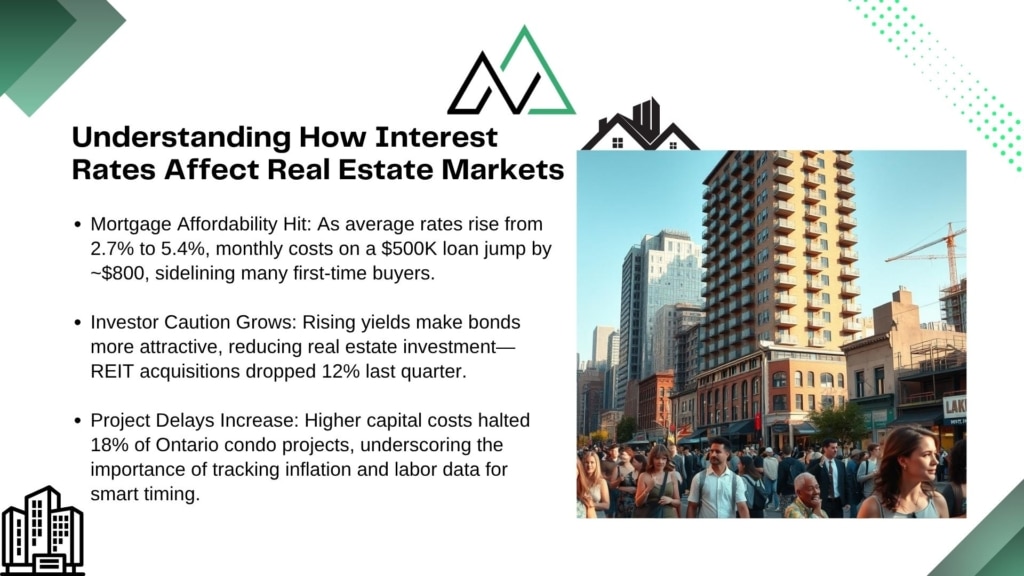Navigating today’s property landscape requires understanding one critical factor: borrowing costs. When central banks adjust policy, mortgage rates shift, reshaping decisions for buyers and investors alike. New Homes Alberta, your trusted partner in Canadian real estate, breaks down these dynamics using actionable data and local expertise.
Higher lending costs influence monthly payments, which can cool buyer activity in the short term. This creates ripple effects across housing availability and pricing. For example, some investors may delay projects due to tighter financing, impacting construction timelines and long-term supply.
Our analysis covers residential and commercial sectors, offering clarity on trends like shifting demand for suburban homes or urban office spaces. Whether you’re buying your first property or expanding a portfolio, grasping these patterns helps you strategize effectively.
With over a decade of experience, New Homes Alberta (403-305-9167) combines verified market insights with practical advice. Stay tuned as we explore strategies to adapt to evolving conditions—from evaluating loan options to identifying emerging opportunities.
Key Takeaways
- Mortgage costs directly respond to central bank policy changes.
- Construction delays may occur when financing becomes stricter.
- Residential demand often shifts toward affordable regions during rate hikes.
- Commercial properties face unique challenges with rising capital expenses.
- Accurate data analysis is critical for timing purchases or sales.
Overview of the Real Estate Market Landscape in Canada

Canada’s property sector reflects a complex interplay of economic forces. The Bank of Canada’s cautious stance on inflation has led to tighter lending policies, creating a cautious environment for buyers and developers. Recent data shows existing home sales dipped 15% year-over-year as borrowing costs climbed, reshaping accessibility for first-time purchasers.
Economic Conditions and Lending Environments
Banks now enforce stricter mortgage qualification criteria, particularly for high-ratio loans. Commercial projects face similar hurdles—reports indicate a 22% decline in construction financing approvals since 2022. This cautious approach stems from rising default risks in both residential and retail spaces.
Market Demand, Supply, and Affordability Trends
Limited inventory persists nationwide, with major cities like Toronto seeing listings 30% below pre-pandemic levels. Buyers increasingly prioritize suburban areas, where prices average 18% lower than urban cores. However, fluctuating mortgage rates keep monthly payments unpredictable, forcing many to delay decisions.
Regulatory measures, like stress-test adjustments, aim to stabilize affordability. Yet average home prices remain 40% higher than 2019, challenging entry-level buyers. Investors adapt by diversifying portfolios with mixed-use properties or rental units, which show steadier demand.
Understanding How Interest Rates Affect Real Estate Markets
Central bank decisions act as a lever, tilting market dynamics in new directions. When borrowing costs rise, two interconnected forces emerge: immediate pressure on loan accessibility and long-term shifts in capital behavior.

Direct Impact on Mortgage Rates and Home Affordability
Policy adjustments by institutions like the Bank of Canada directly influence lending terms. Freddie Mac reports average fixed mortgage rates doubled from 2.7% in 2021 to 5.4% today. For a $500,000 loan, this adds nearly $800 to monthly payments—pushing many buyers toward smaller homes or delaying purchases entirely.
Rob Haworth, Senior Investment Strategist at U.S. Bank Wealth Management, notes:
“Affordability constraints now dictate market entry points. First-time purchasers face tougher trade-offs between location, size, and budget.”
Indirect Effects on Investment and Capital Flows
Higher yields on bonds and savings accounts divert funds from property investments. Recent data shows a 12% quarterly drop in Canadian REIT acquisitions as institutional players rebalance portfolios. Developers also face tighter financing—18% of planned condo projects in Ontario were paused last year due to rising capital costs.
These trends highlight why monitoring economic indicators like inflation reports and employment data is critical. Savvy stakeholders use such insights to anticipate demand shifts and identify undervalued opportunities.
Trend Analysis: Impact on Commercial and Residential Properties
Diverging patterns emerge when comparing Canada’s commercial and residential sectors. While both face pressure from evolving economic conditions, their responses reveal contrasting risk profiles and opportunities.

Commercial Real Estate: Credit and Yield Dynamics
EY’s 2023 analysis highlights a 70% plunge in commercial transaction volumes nationwide. Office spaces face heightened scrutiny—vacancy rates exceed 18% in Toronto as hybrid work reshapes demand. Rising capitalization rates now average 6.2%, up from 4.8% pre-pandemic, signaling investor caution.
Tighter lending standards compound challenges. Banks now require 35-40% equity for commercial loans, compared to 25% in 2021. This liquidity crunch stalls projects, particularly in retail and hospitality segments.
Residential Market: Sales, Inventory, and Price Movements
Residential markets show more resilience despite 22% fewer sales year-over-year. Vancouver’s inventory sits 40% below 2019 levels, creating competitive bidding in suburban areas. Average prices dipped 8% nationally but stabilized in Q1 2024 as buyers adapted to higher mortgage rates.
- Condos in Calgary rose 4.1% quarterly due to affordability demands
- Single-family home construction permits fell 19% amid financing hurdles
- Rental vacancies hit 30-year lows, pushing rents up 13% annually
As RBC economist Claire Fan observes:
“The divide between asset classes underscores the need for targeted strategies. Investors prioritizing cash-flow stability lean toward residential, while commercial players await clearer yield signals.”
Regional Spotlight: The British Columbia Housing Market
British Columbia’s property landscape balances coastal allure with complex economic pressures. Metro Vancouver’s benchmark home price sits at $1.2 million—35% above the national average—yet shifting mortgage rates and regulatory measures create uneven opportunities across the province.
Property Values and Shifts in Buyer Demand
When borrowing costs dipped below 3% in 2021, Victoria saw condominium prices surge 23% annually. Today’s mortgage rates near 6% have cooled this growth, with suburban townhomes now attracting 40% of buyer inquiries. First-time purchasers increasingly target communities like Langford, where entry-level units cost 28% less than downtown Victoria.
Government Policies and Their Role in Market Regulation
BC’s 2023 foreign buyer tax increase to 20% slowed luxury sales in West Vancouver by 15% last quarter. Simultaneously, federal stress test adjustments require borrowers to qualify at rates 2% above contracted levels—a policy reducing purchasing power by $150,000 for median-income households.
Local developer Marco Jansen notes:
“Investors now prioritize cash-flow positive multi-family units over speculative land deals. Policy shifts have reshaped risk calculations across asset classes.”
These dynamics highlight BC’s delicate balance between affordability measures and sustaining property values. While national trends show stabilization, regional factors like migration patterns and coastal development restrictions keep this housing market uniquely responsive to economic signals.
Strategic Considerations for Investors and Homebuyers
Adapting to financial shifts requires both caution and creativity. With mortgage rates now tracking 10-year Treasury yields, borrowers face monthly payments 45% higher than 2021 averages. Strategic adjustments help mitigate risks while uncovering hidden opportunities.
Navigating Rising Mortgage Rates and Market Uncertainties
Flexibility becomes critical when borrowing costs fluctuate. Consider these approaches:
| Strategy | Benefit | Consideration |
|---|---|---|
| Adjustable-rate mortgages | Lower initial payments | Future rate hike exposure |
| 20%+ down payments | Reduces loan premiums | Liquidity constraints |
| Rate lock extensions | Secures favorable terms | Upfront fee costs |
Rob Haworth emphasizes:
“Align purchase timelines with Federal Reserve meeting cycles. Historical data shows 68% of rate changes occur within 6 weeks of policy announcements.”
Building Resilient Real Estate Investment Portfolios
Diversification shields against localized downturns. Allocate assets across:
- Multi-family rentals (12% annual ROI in Calgary)
- Industrial warehouses (8% vacancy rates nationally)
- REITs with mixed-use developments
Track leading indicators like building permit trends and rental vacancy rates. For example, Edmonton saw a 19% jump in rental applications as property values stabilized—a signal for income-focused investors.
Conclusion
Economic shifts reshape property strategies across Canada. Rising borrowing costs influence mortgage affordability, cooling buyer activity while redirecting investment toward resilient assets like multi-family rentals. Commercial sectors face tighter financing, with transaction volumes dropping 70% since 2022, while residential markets adapt through suburban demand shifts and rental growth.
British Columbia exemplifies regional contrasts—luxury sales declined amid policy changes, yet suburban townhomes thrive. Nationally, data reveals 40% fewer urban listings compared to pre-pandemic levels, pushing property values in affordable regions upward.
For stakeholders, flexibility remains key. Adjustable-rate loans, portfolio diversification, and monitoring employment trends help navigate uncertainties. New Homes Alberta combines localized insights with verified analytics to guide decisions in evolving conditions.
Connect with our team at 403-305-9167 for tailored strategies. Whether analyzing housing affordability trends or commercial yield potentials, informed choices unlock opportunities even as economic landscapes shift.
FAQ
Why do mortgage rate changes influence housing affordability?
Higher borrowing costs reduce purchasing power, forcing buyers to adjust budgets or delay decisions. This shifts demand toward lower-priced properties and can slow price growth in competitive markets like Vancouver or Calgary.
How do investors adapt portfolios during rising rate environments?
Many diversify into mixed-use developments or stabilized rental properties to offset financing risks. Tools like REITs or adjustable-rate loans also help balance cash flow against capital expenditure pressures.
What separates commercial and residential market reactions to rate hikes?
Office and retail spaces face tighter credit access, impacting valuations. Residential markets see faster inventory turnover in affordable segments, while luxury home sales may decline due to higher carrying costs.
Has British Columbia’s market seen unique trends amid recent rate increases?
Yes. Cities like Victoria experienced shorter listing periods for townhomes under $800K, while luxury condo demand softened. Provincial first-time buyer incentives partially offset affordability challenges.
What strategies improve resilience for real estate investments today?
Focus on markets with strong job growth, like Edmonton’s tech corridors, and consider properties with energy-efficient features to attract tenants. Locking in fixed-rate mortgages early provides predictable expenses.
Can government policies counteract rising interest rate impacts?
Initiatives like Alberta’s tax rebates for new builds or BC’s speculation tax adjustments help stabilize local markets. However, broader rate trends set by the Bank of Canada remain dominant drivers.
How do yield dynamics shift in commercial real estate?
Cap rates often rise as borrowing costs increase, pressuring valuations. Industrial assets near logistics hubs, like those in Ontario’s Golden Horseshoe, maintain stronger yields due to e-commerce demand.





